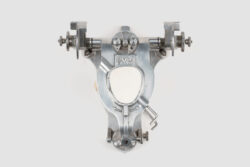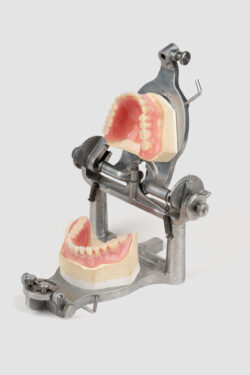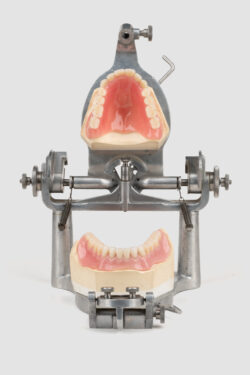Semi-adjustable articulator
Star Object: Semi-adjustable articulator
While dentistry is always viewed as a rigid, medical science that is rooted in biology and pathology, underlying it is an overlooked science of motion, angles, hinges, and axes. Biomechanics are naturally found in a human jaw, the choreography of the muscle’s force, bone structure, and joint dynamics.
The mandible movements are way too complex to be described as a hinge that opens and closes; it glides, rotates, translates, and adapts. The Temporomandibular Joint that connects the mandibular jaw to the skull houses a universe of motions that defies simplicity, leaving any prosthodontic work to be more inclined towards guessing and average values rather than guided accuracies.
The inventions of articulators serving as a mechanical surrogate of the skull and the motions it holds came to aid the fabrication of dental prosthesis. The first models trying to replicate what the human body offers only held rudimentary movements, ignoring the nuances and complexity of the muscular harmony. But as our understanding deepened, so did our desires for replication, rather than just approximation. The leap came with the introduction of semi-adjustable articulators, which stood as a pivotal point that upgraded restorative dentistry and prosthodontics.
Since then, physics and jaw dynamics shifted the scope of prosthodontics into more dynamic and functional, as movements were no longer considered abstract ideas, but rather measurable, and recordable, paying respect to the mechanical system of the skull and jaw, were they critical clinical relevance. Angles mattered. Axes mattered. Velocity, force, and torque all began to speak through adjustable pins and calibrated pathways.
To place a crown, create a denture, or install a bridge was no longer considered a two-dimensional approach, but moved to be three dimensional. The semi-adjustable articulator brough physics out of the textbooks, and into wax, acrylic resin, and porcelain, where theory meets practice, and theoretical sciences served a more complex biological and pathological matter to become a blueprint of healing.
The pictures show a wax try-in denture mounted on an articulator that seems to be semi-adjustable.
Semi-adjustable articulators are more complex yet provide a more accurate simulation of the anatomical movements of the Temporomandibular Joint (TMJ) than previously used articulators. Previously, articulators used to be simpler, only simulating the opening of the jaw by a simple hinge movement.
Because the human body is always more complex, hinge articulators don’t simulate the movement of the TMJ like it really is. In a human body, full mouth opening happens in two stages: rotation, and translation. Stage one is rotation, where the joint acts as a hinge opening the mouth up to 20-25mm. Stage two of the mouth opening is called translation, where the mandible slides forward and downward instead of simulating a hinge movement, opening the mouth further than 25mm.
This led towards using an articulator that respects the complexity of the anatomy of the TMJ, which is the mean-value articulator. The mean-value articulator depends on the average values of the anatomical structures involved in the TMJ movement among the population, including Condylar Guidance Angle, Bennett Angle, Incisal Angle etc... While this articulator respects the complexity in the movement, it doesn’t consider the anatomical variations between different patients. Dr. Alfred Gysi introduced the semi-adjustable articulator in the early 1900s, hoping to overcome the shortcomings of previous articulators.
In the pictures, the semi-adjustable articulator is “non-arcon”, where the condylar elements are attached to the upper member, and the condylar guidance is part of the lower member. And although the anatomy of the TMJ is the other way around, the non-arcon semi-adjustable articulator was closer to precisely mimicking the movements of the TMJ than other previously used articulators.

This articulator allows more adjustment to the Condylar Angles, Bennett angle, Intercondylar Distance, opening and closing axis, and incisal guidance to be customized specifically for every patient’s unique jaw movement, unlike mean-value articulators where the movements are fixed to the metal tracks in the articulator.
These measurements of the articulator are customized to each patient’s jaw movements, taking some of the uniqueness of patients’ anatomy into consideration. This is done by using a “facebow”, as it aids in recording the spatial relationship to the TMJ, and the base of the skull during movements of the Jaw.
The semi-adjustable articulator has been recognized for its high accuracy in capturing and allowing the replication of the TMJ movements. This allowed producing longer-lasting treatments, and improved prostheses’ fabrication. It has also improved patient’s comfort and allowed dentists to treat more complex cases where TMJ disorders and asymmetry is found, to overcome the idea of standardized fabrication methods.
When it comes to prosthesis, the semi-adjustable articulator, literally and figuratively, drew a path to success in treatments. This articulator eased a more accurate fit of crowns and bridges, reduced the need for adjustments, and produced better occlusal relationships. When it comes to dentures, the more precise capture of measures aided in producing dentures that are more retentive and stable, which optimized the patients’ comfort allowing them to adhere to wearing their new dentures.
Adding to that, when it came to aesthetics, using a semi-adjustable articulator provided better direction for the dentist when planning the treatment, as understanding the jaw movements influences the choice of aesthetics in a way that enhances the facial harmony of the patient. Not only that, but understanding the scope of the sophisticated movements, to an extent, facilitates full-mouth rehabilitation treatments, where complex reconstructions become less intricate, and with better treatment outcomes.
The semi-adjustable articulator’s role wasn’t constricted to only prosthesis, as it also plays a crucial role in diagnosis. Because it can replicate the jaw’s movement, the semi-adjustable articulator allows more accurate comprehension of the oral dynamics, aiding in the identification of any interferences in the movements and their paths that can cause TMJ disorders and dysfunctions.
Although the introduction of the semi-adjustable articulator represents a significant advancement in prosthetic dentistry, it still was limited in replicating the full anatomy of the TMJ and patient-specific movements, as some of its measured still depend on average anatomical values, and although the precision of replication was improved, some details were still missing.
The semi-adjustable articulator still used an average value when it came to the Condylar Guidance (condylar path) and the exact location of the hinge axis, using an estimation of the shape and steepness of the articular eminence of the TMJ, as the skeletal structure plays a huge role in the exact measures of each jaw movement, which are often unique in each patient. Pathologies such as degeneration, disc displacement, and inflammation of the TMJ can also alter the anticipated jaw movements. Adding to that; oral conditions such as bruxism can alter the anatomy of the TMJ in the long run, forcing the movements to deviate from average anatomical values. And although semi-adjustable articulators marked a substantial leap when it came to full-mouth rehabilitation treatments, such treatments often need flawless imitation of the real-life movements of the jaw.


Fully-adjustable articulators were later introduced for such cases, where estimation of some values created a barrier rather than a facilitator of treatment. These articulators allowed dentists to record the condylar guidance’s path individually during protrusive and lateral movements, providing superior, more intricate details for each patient.
Nevertheless, and although fully-adjustable articulators provide superior precision, the semi-adjustable articulators remain the most used in dental clinics to this day. This is due to their practicality and ease of use, and because of the time efficiency they provide, as it still delivers reliable results in most clinical cases.
